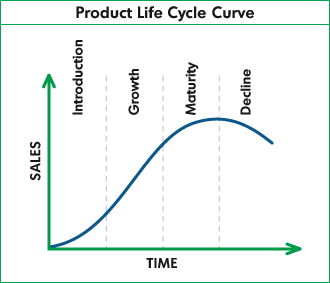This content was originally published more than ten years ago and is archived here for preservation.
More up-to-date content is available on this blog.
Do you find it difficult to set appropriate financial targets for your product? Recently I’ve been attempting to simplify the process as part of my planning for my company’s next fiscal year and wanted to share an approach I’ve found helpful with you. I’ve created a straightforward spreadsheet, which you are welcome to download and adapt for your own purposes.
Current Performance
First of all you need to know how your product is currently performing. If you don’t know, you should. Go and speak to your Sales and Finance departments and find out. Go on.
Back now? Jolly good.
Organic Growth (or Decline)
With that knowledge, the next thing for you to consider is at what stage in its life cycle is your product. Is it:
- a new product being introduced and growing slowly (Introduction)
- an existing product in its rapid growth phase (Growth)
- an established product exhibiting slight or no growth (Maturity)
- a product phasing out and in decline (Decline)
A good description of these phases, often referred to as the Product Life Cycle, can be found on Tom Spencer’s consulting blog. This will allow you to predict how it’s revenue should be growing (or declining) irrespective of any new initiatives that will generate additional revenue. This is your baseline financial performance resulting from new sales of your product.
Incremental Growth
Then you need to consider any new initiatives that will generate additional revenue, such as a new feature release, an advertising campaign or a limited-time offer on upgrades at a discounted price. This forms your product’s incremental performance resulting from new sales.
You also need to consider repeat business such as annual maintenance, or renewed subscriptions to your service. The key considerations here are:
- how much do customers pay in the second (and subsequent) years compared to what they paid in the first year?
- how good is your company at retaining your customers from year to year?
Royalties or Licence Fees
Lastly you need to factor in any royalties or licence fees that you need to pay third parties every time you sell your product. This could be a licence of a bundled product, such as a PDF viewer or a reporting package. You might need to pay these only at point of sale, on an ongoing basis each year a customer is using your product, or not at all.
Wrapping It Up
With all this information at your fingertips, you can simply plug it into the Product Fiscal Forecast spreadsheet and it will calculate your forecast for you. This is a good starting point to benchmark your product’s financial performance for the following year.
Caveat Lector
This is definitely not a full accountancy tool. It doesn’t take into account any associated product costs other than the royalties / licence fees payable to third parties. What it does tell you is approximately how much you should expect your product to make in the next financial year.
Please feel free to post a comment if it has helped you, or if you have any suggestions for improvement.
References:
- Product Life Cycle on Tom Spencer’s consulting blog.
- Product Fiscal Forecast spreadsheet




















